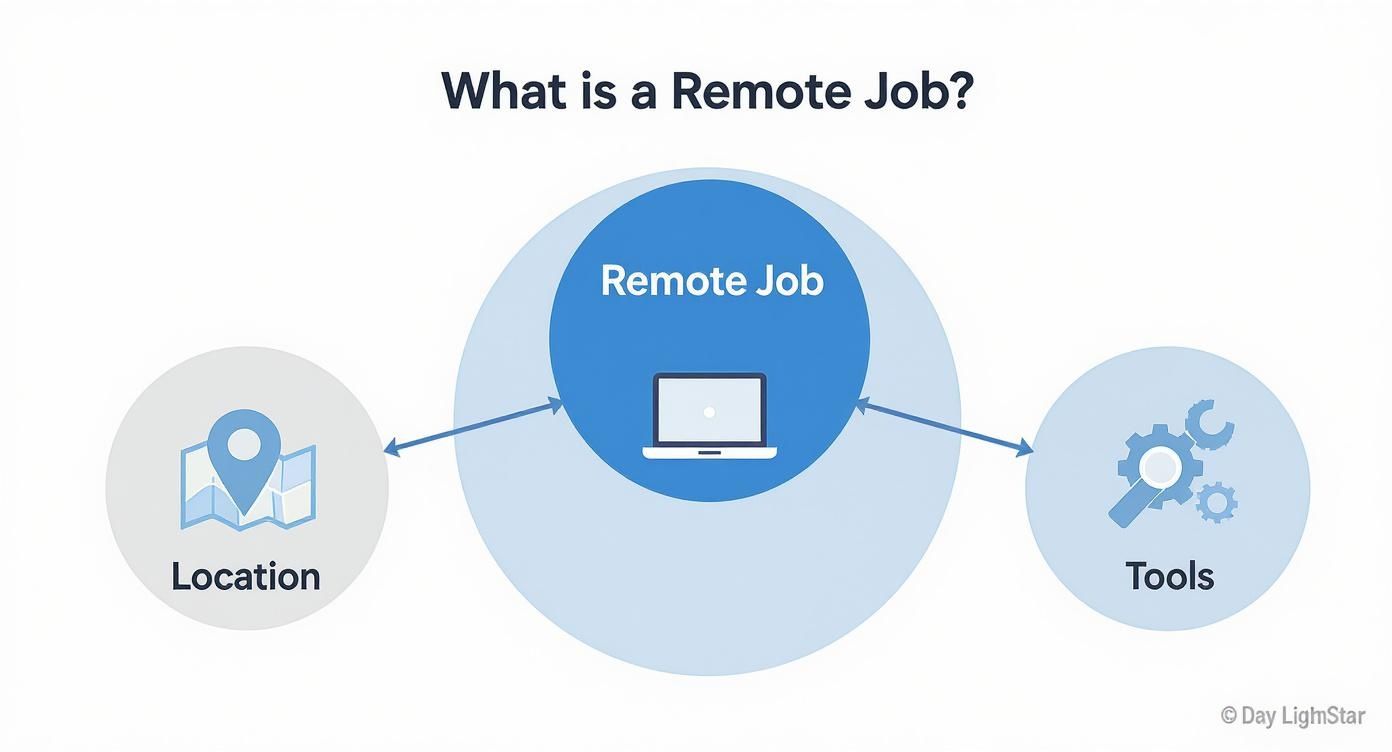What Is a Remote Job A Practical Guide

So, what exactly is a remote job?
At its core, a remote job is simply any role you perform outside of a traditional, central office. Instead of commuting to a specific building every day, you use technology to connect with your team and get your work done from pretty much anywhere—your home office, a local coffee shop, or even a co-working space on the other side of the world.
Understanding What a Remote Job Really Means
Think of it less as a job type and more as a job style. While the specific tasks might be the same as an in-office role, the way you work is completely different. It all boils down to a few key ingredients that make it possible.
The Building Blocks of Remote Work
- Location Independence: This is the big one. As long as you have a reliable internet connection, your "office" can be wherever you want it to be.
- Digital Communication: Forget tapping a colleague on the shoulder. Communication happens through tools like Slack for instant messaging, Zoom for video meetings, and email.
- Flexible Scheduling: Many remote jobs offer more control over your workday. You might still have core hours, but there's often freedom to structure your day around your life, not the other way around.
- Tech-Powered Tools: Your entire workflow lives online. This means getting comfortable with project management software, cloud storage, and other digital tools that keep everyone in sync.
To put it all together, here’s a quick overview of the essentials.
Remote Job Essentials at a Glance
| Aspect | Details |
|---|---|
| Definition | Any work performed outside of a traditional, centralized office environment. |
| Flexibility | Often includes choices in location (where you work) and sometimes schedule (when you work). |
| Common Roles | Tech developers, digital marketers, customer support agents, writers, and designers. |
| Key Advantages | Greater autonomy, significant cost savings on commuting, and better work-life balance. |
These core elements are what define the modern remote work experience, from a startup to a global corporation.
The shift toward this way of working isn't just a niche trend; it's a massive global movement. You can see just how much it has exploded, especially since 2020, in data on worldwide adoption rates.
This rapid growth shows that remote work is more than just a temporary fad—it's a fundamental change in how we think about our careers and daily lives.
What Does "Remote Work" Actually Mean?
To really get what a remote job is, you have to look past the simple idea of "working from home." It’s a completely different way of thinking about work itself.
Think of a remote team like a constellation. Each person is a star, shining from their own unique spot in the world, yet they're all connected to create one cohesive and brilliant picture. This is a huge departure from the traditional office setup we're all used to.
This shift is more than just about changing your physical location; it's a fundamental change in culture. Thriving in a remote role means moving away from the old-school "butts in seats" mentality, where being present is mistaken for being productive. Instead, it’s all about a results-driven environment. The focus is squarely on the quality of your output and meeting deadlines—not where you are when you get the work done.
The Different Flavors of Remote Work
It's important to know that "remote-friendly" isn't a one-size-fits-all term. Jobs typically fall into one of three main buckets, each with its own level of flexibility:
- Fully Remote: This is the big one. Your job is 100% location-independent. As long as you have a solid internet connection, you can work from pretty much anywhere without ever needing to step foot in an office.
- Hybrid: This model gives you a mix of both worlds. You might work from home a few days a week and head into a central office for the others. It's a blend of remote freedom and in-person collaboration.
- On-Site: This is the classic 9-to-5 model. You're expected to be physically present at the company’s office for your entire work schedule.
This infographic does a great job of breaking down the core ideas—location and tools—that really define what a remote job is all about.

As you can see, the whole structure of remote work is built on two key pillars: location independence and the digital tools that make it all possible.
And this isn't a niche trend anymore. The growth has been massive. By 2024, an estimated 35.1 million workers in the U.S. were working remotely at least some of the time. You can dive deeper into the remote work trends that show just how much this shift has been driven by real gains in productivity and employee happiness.
Why More People Are Choosing Remote Jobs
It’s not just a trend; it's a fundamental shift in how we think about work. The engine driving this change is a powerful desire for more control over our lives and a better balance between our careers and everything else.
Think about it: what if you could swap that soul-crushing daily commute for an extra hour with your family? Or maybe use that time for a morning run or to finally tackle a passion project? For millions, this isn't a hypothetical—it's the reality of remote work.
But this isn't a one-sided deal. Companies are getting just as much out of this as their employees are. When a business opens its doors to remote talent, they’re suddenly fishing in a global pond instead of a local puddle. They can hire the absolute best person for the job, whether that person lives across the street or across an ocean.
The View from Your Home Office
If you’re the one working remotely, the perks are pretty clear and hit close to home. The freedom to build a workday that actually fits your life is a game-changer, and it has a massive impact on overall happiness and mental health.
- Real Flexibility: You can actually structure your day around your life's real demands, like school pickups, doctor's appointments, or just walking the dog when it’s not pouring rain.
- Serious Savings: The money you save on gas, public transport, a professional wardrobe, and those tempting daily lunches adds up—fast.
- True Autonomy: You're in charge of your own space and your schedule. That sense of ownership is incredibly empowering and often leads to better, more focused work.
Why Companies Are on Board
For businesses, going remote is more than just a popular move; it’s a smart one. The most obvious win is financial. Ditching a massive physical office means slashing huge overhead costs like rent, utilities, and maintenance.
But the benefits go straight to the bottom line in other ways, too. Happy, empowered employees tend to be incredibly productive. In fact, global analyses show that remote workers can see a productivity bump of 35% to 40% because they have fewer office distractions and can create an environment where they can truly concentrate. That kind of increased output is something no company can ignore, as highlighted in these recent remote work statistics and insights.
A remote-first approach allows organizations to invest resources back into their people and technology, creating a more resilient and efficient operational model for the future. This is a strategic shift, not just a temporary perk.
Navigating the Challenges of Remote Work

As great as remote work sounds, it’s not all sunshine and sweatpants. The same freedom that draws people in can also create some unique headaches that you just don't run into in a traditional office. It's a completely different environment that demands a new kind of discipline.
One of the biggest hurdles is the disappearing line between work and home life. When your office is your living room, it's incredibly tough to mentally "clock out" at 5 PM. This constant connection can easily lead to burnout.
Another common struggle is isolation. You miss out on all those little impromptu chats—the quick coffee run, the conversation by the water cooler—that build team camaraderie. Without that built-in social fabric, loneliness can creep in, and you have to be much more intentional about connecting with your colleagues.
Creating Structure and Connection
To really thrive in a remote job, you have to tackle these challenges head-on. You're basically in charge of building the structure an office used to provide for you. That means carving out a dedicated workspace and setting hard boundaries for when your workday starts and ends.
Here are a few strategies seasoned remote workers swear by:
- Fake a commute: Use the 15-30 minutes you would have spent commuting to go for a walk, read a book, or do something to create a mental buffer between your personal time and work time.
- Schedule virtual coffee chats: Put a 15-minute "non-work" call on the calendar with a teammate. It’s a great way to replicate those spontaneous office conversations.
- Find your online tribe: Join Slack groups or other online communities for professionals in your industry. This helps you build a network beyond your immediate team.
Tackling these issues is non-negotiable for long-term success. A remote job gives you incredible autonomy, but that same freedom means you're fully responsible for your own productivity and well-being.
Getting familiar with the common challenges of working remotely is the first step. By building intentional routines, you can sidestep the common pitfalls and truly enjoy the flexibility you signed up for.
How to Find and Land Your First Remote Job

Making the move to a remote career isn't just about finding a job you can do from home; it's about proving you can thrive without someone looking over your shoulder. You need a strategy, and it all starts with how you present your skills and experience.
Think less about just listing technical skills and more about telling a story. Hiring managers want to see that you have the soft skills to succeed on your own. Focus on your knack for asynchronous communication, your solid self-discipline, and your ability to be a proactive problem-solver.
Instead of saying you're a team player, talk about that one project where you coordinated with people across different departments entirely through Slack and email. That's a real-world example of remote-readiness.
Finding Legitimate Opportunities
The internet is flooded with job postings, but not all are created equal. While you can find remote jobs on big, general platforms, your best bet is to zero in on sites that only list remote positions. These curated boards cut through the clutter and connect you with companies that truly understand and support remote work.
One of the biggest mistakes people make is sending the same generic resume everywhere. Customize it! Weave in keywords and phrases from the job description to show them you’re paying attention and are the perfect person for that specific role.
If you're not sure where to begin, we've put together a comprehensive guide on how to find remote work that points you to the best resources.
Perfecting Your Remote-Ready Application
Your cover letter is where you seal the deal. This is your chance to directly address the elephant in the room: can you really handle the freedom of a remote job? Don't just claim you're a "self-starter"—back it up with a quick story that proves it.
Here’s how to make your application impossible to ignore:
Showcase Your Tech-Savviness: Don't be shy. Name-drop the remote collaboration tools you’ve mastered, like Slack, Asana, Trello, or Zoom.
Highlight Proactive Communication: Talk about a time you saw a potential roadblock and flagged it for the team before it derailed a project. This shows foresight.
Demonstrate a Results-Oriented Focus: Frame your past wins around what you actually accomplished. Instead of saying you "worked on a project for 80 hours," talk about the outcome—like increasing sign-ups by 15%.
How to Spot and Avoid Remote Job Scams
The explosion in remote work has been amazing for job seekers, but it's also created a perfect hunting ground for scammers. They're getting craftier, so knowing their tricks is your best defense. Think of this as your personal scam detector for navigating the remote job market.
The most glaring red flag? Any request for money. Period. A legitimate company will never ask you to pay for your own background check, training materials, or work equipment. That's a scam, 100% of the time.
Another easy-to-spot sign is sloppy communication. Real recruiters and hiring managers work for real companies. They use professional email addresses (like name@company.com, not name@gmail.com) and their messages are generally free of glaring typos and grammatical errors.
If a job posting promises an outrageous salary for simple, entry-level tasks, be skeptical. When an offer seems too good to be true, it almost always is.
A Quick Scam-Spotting Checklist
Before you get too excited about a new opportunity, run it through this quick mental checklist. It could save you a world of trouble.
- Vague Job Details: Scammers are often fuzzy on the specifics. Legitimate listings will clearly outline the role, responsibilities, and required qualifications.
- Unprofessional Interviews: Is the entire "interview" happening over a chat app like Telegram or WhatsApp? That's a huge red flag. Real interviews typically involve a video or phone call with a real person.
- Pressure to Act Fast: Scammers thrive on urgency. They'll push you to accept an offer immediately before you have time to think it through or notice the warning signs.
Staying vigilant is the key. Trust your gut, and don't be afraid to walk away from anything that feels off. For a more detailed breakdown of common scams and how to verify a company is legitimate, check out our full guide on avoiding remote job scams.
Let's be clear: remote work isn't some passing fad that came and went with the pandemic. It’s here to stay, fundamentally changing what a "career" even looks like.
The future isn't a simple choice between the office and your home. Instead, it’s all about flexibility. Think less about a binary switch and more about a spectrum of possibilities.
What we're seeing take over is the hybrid model. Companies are finally figuring out that you can have the best of both worlds—the focused, deep work that happens at home, combined with the creative energy and collaboration that sparks in the office. It’s about giving people the autonomy they crave while still nurturing a real sense of team and culture.
And as technology gets better, even jobs we once thought were permanently tethered to a physical place are breaking free. We're seeing this in certain healthcare roles, education, and beyond, completely redrawing the lines of labor markets across the globe.
The numbers back this up. In the U.S. alone, 24% of all professional job postings are already for hybrid positions, and another 12% are fully remote. If you want to dive deeper, you can explore more data on how flexibility is shaping future job markets and see just how powerful this shift has become.
Ultimately, the future of work is about choice. It's about companies trusting their teams and employees designing a career that fits their lives, not the other way around.
